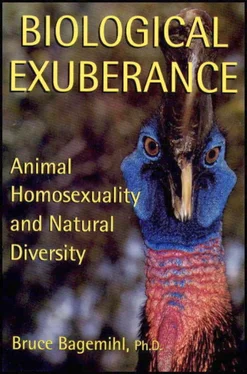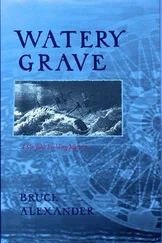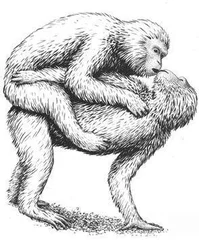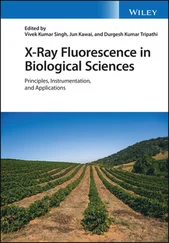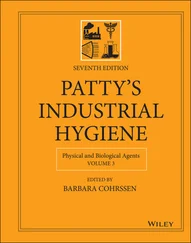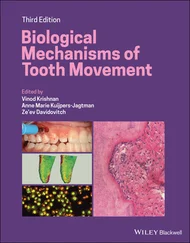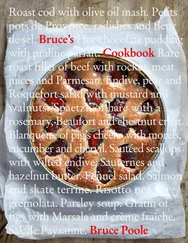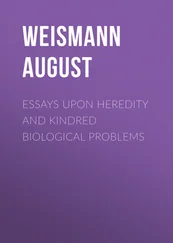107
Chaffinch (Marler 1956:113—14, 163 [table XI]); African jacana (Jenni, D. A. [1996] “Jacanidae [jacanas],” p. 282, in J. del Hoyo, A. Elliott, and J. Sargatal, eds., Handbook of the Birds of the World , vol. 3: Hoatzin to Auks, pp. 276—91 [Barcelona: Lynx Edicións]). For further examples and statistics on the widespread occurrence of matings that “fail” to result in insemination, see Eberhard, Female Control , pp. 399—403.
108
For a general survey of mating harassment in primates, see Niemeyer, C. L., and J.R. Anderson (1983) “Primate Harassment of Matings,” Ethology and Sociobiology 4:205-20.
109
Asiatic Elephant (Eisenberg et al. 1971:205). For specific examples of male and female genitalia that do not “fit,” see Eberhard, W. G. (1985) Sexual Selection and Animal Genitalia (Cambridge, Mass.: Harvard University Press). On the hostility of the female’s reproductive tract to sperm, see Birkhead, T. R., A. P. Møller, and W. J. Sutherland (1993) “Why Do Females Make It So Difficult for Males to Fertilize Their Eggs?” Journal of Theoretical Biology 161:51-60; Birkhead, T., and A. Møller (1993) “Female Control of Paternity,” Trends in Ecology and Evolution 8:100-104; Eberhard, Female Control, pp. 331—49.
110
Musk-ox (Smith 1976:54—55).
111
Clutton-Brock, T. H., and G. A. Parker (1995) “Sexual Coercion in Animal Societies,” Animal Behavior 49:1345-65; Smuts, B. B., and R. W. Smuts (1993) “Male Aggression and Sexual Coercion of Females in Nonhuman Primates and Other Mammals: Evidence and Theoretical Implications,” Advances in the Study of Behavior 22:1-63; Palmer, C. T. (1989) “Rape in Nonhuman Animal Species: Definitions, Evidence, and Implications,” Journal of Sex Research 26:355-74; McKinney et al. 1983 (Ducks).
112
For further examples and references, see Le Boeuf and Mesnick 1991 (Northern Elephant Seal); Miller et al. 1996 (Northern Fur Seal).
113
Pronghorn (Geist 1990:283).
114
Besides mating during the nonbreeding season or during menstruation or pregnancy, many female mammals also copulate during anovulatory cycles, that is, menstrual cycles during which ovulation has not taken place (Baker and Bellis, Human Sperm Competition , pp. 69-70; Eberhard, Female Control, pp. 133-39).
115
Eberhard, Female Control , pp. 3—5, 202.
116
Birkhead et al., “Why Do Females Make It So Difficult for Males to Fertilize Their Eggs?” p. 52; Birkhead and Møller, “Female Control of Paternity,” p. 101; Ginsberg, J. R., and U. W. Huck (1989) “Sperm Competition in Mammals,” Trends in Ecology and Evolution 4:74-79; Eberhard, Female Control, pp. 81-94.
117
Rodents (Voss, R. S. [1979] “Male Accessory Glands and the Evolution of Copulatory Plugs in Rodents,” Occasional Papers of the Museum of Zoology, University of Michigan 689:1—27; Baumgardner, D. J., T. G. Hartung, D. K. Sawrey, D. G. Webster, and D. A. Dewsbury [1982] “Muroid Copulatory Plugs and Female Reproductive Tracts: A Comparative Investigation,” Journal of Mammalogy 63:110-17); Squirrel Monkey (Srivastava et al. 1970:129-30); Hedgehogs (Reeve 1994:178; Deansley, R. [1934] “The Reproductive Processes of Certain Mammals. VI. The Reproductive Cycle of the Female Hedgehog,” especially p. 267, Philosophical Transactions of the Royal Society of London , Series B 223:239-76); lemurs and other prosimians (Dixson, A. E [1995] “Sexual Selection and the Evolution of Copulatory Behavior in Nocturnal Prosimians,” in L. Alterman, G. A. Doyle, and M. K. Izard, eds., Creatures of the Dark: The Nocturnal Prosimians , pp. 93-118 [New York: Plenum Press]); Dolphins (Harrison, R. J. [1969] “Reproduction and Reproductive Organs, p. 272, in H. T. Andersen, ed., The Biology of Marine Mammals , pp. 253-348 [New York and London: Academic Press]); on “chastity plugs” in Bats, see Fenton, M. B. (1984) “Sperm Competition? The Case of Vespertilionid and Rhinolophid Bats,” in Smith, R. L. (1984) Sperm Competition and the Evolution of Animal Mating Systems , pp. 573-87 (Orlando: Academic Press); Squirrels (Koprowski 1992). For additional species, as well as other examples of females removing plugs, see Eberhard, Female Control , pp. 146-55.
118
Common Chimpanzee (Dahl et al. 1996).
119
Bruce, H. M. (1960) “A Block to Pregnancy in the Mouse Caused by Proximity of Strange Males,” Journal of Reproduction and Fertility 1:96-103; Schwagmeyer, P. L. (1979) “The Bruce Effect: An Evaluation of Male/ Female Advantages,” American Naturalist 114:932-38; Labov, J. B. (1981) “Pregnancy Blocking in Rodents: Adaptive Advantages for Females,” American Naturalist 118:361—71. See also Eberhard, Female Control, pp. 162—66.
120
Springer, S. (1948) “Oviphagous Embryos of the Sand Shark, Carcharias taurus ,” Copeia 1948:153—57; Gilmore, R. G., J. W. Dodrill, and P. A. Linley (1983) “Reproduction and Embryonic Development of the Sand Tiger Shark, Odontaspis taurus (Rafinesque),” Fishery Bulletin U.S. 81:201—25; Gilmore, R. G. (1991) “The Reproductive Biology of Lamnoid Sharks,” Underwater Naturalist 19:64—67; Kuzmin, S. L. (1994) “Feeding Ecology of Salamandra and Mertensiella: A Review of Data and Ontogenetic Evolutionary Trends,” Mertensiella 4:271-86.
121
Geist, V. (1971) “A Behavioral Approach to the Management of Wild Ungulates,” in E. Duffey and A. S. Watt, eds., The Scientific Management of Animal and Plant Communities for Conservation , pp. 413—24 (London: Blackwell).
122
California sea lion (Le Boeuf, B. J., R. J. Whiting, and R. F. Gantt [1972] “Perinatal Behavior of Northern Elephant Seal Females and Their Young,” p. 129, Behavior 43:121—56; Odell, D. K. [1970] “Premature Pupping in the California Sea Lion,” in Proceedings of the Seventh Annual Conference on Biological Sonar and Diving Mammals , pp. 185-90 [Menlo Park, Calif.: Stanford Research Institute]). On selective abortion as a mechanism females use to control paternity, see Birkhead and Moller, “Female Control of Paternity,” p. 102. On possible deliberate ingestion of abortifacient plants by primates, see Bewley, D. (1997) “Healing Meals?” BBC Wildlife 15(9):63; Garey, J. D. (1997) “The Consumption of Human Medicinal Plants, Including Abortifacients, by Wild Primates,” American Journal of Primatology 42:111. On abortion in other species not profiled in part 2, see Stehn, R.A., and 1. J. Jannett, Jr. (1981) “Male-induced Abortion in Various Microtine Rodents,” Journal of Mammalogy 62:369—72; Gosling, L. M. (1986) “Selective Abortion of Entire Litters in the Coypu: Adaptive Control of Offspring Production in Relation to Quality and Sex,” American Naturalist 127:772—95; Berger, J. (1983) “Induced Abortion and Social Factors in Wild Horses,” Nature 303:59-61; Kozlowski, J., and S. C. Stearns (1989) “Hypotheses for the Production of Excess Zygotes: Models of Bet-Hedging and Selective Abortion,” Evolution 43:1369—77; Schadker, M. H. (1981) “Postimplantation Abortion in Pine Voles ( Microtus pinetorum ) Induced by Strange Males and Pheromones of Strange Males,” Biology of Reproduction 25:295-97.
On ovicide, see Heinsohn, R. G. (1988) “Inter-group Ovicide and Nest Destruction in Cooperatively Breeding White-winged Choughs,” Animal Behavior 36:1856—58. On egg ejection, see St. Clair, C. C., J. R. Waas, R. C. St. Clair, and P. T. Boag (1995) “Unfit Mothers? Maternal Infanticide in Royal Penguins,” Animal Behavior 50:1177-85.
Читать дальше
